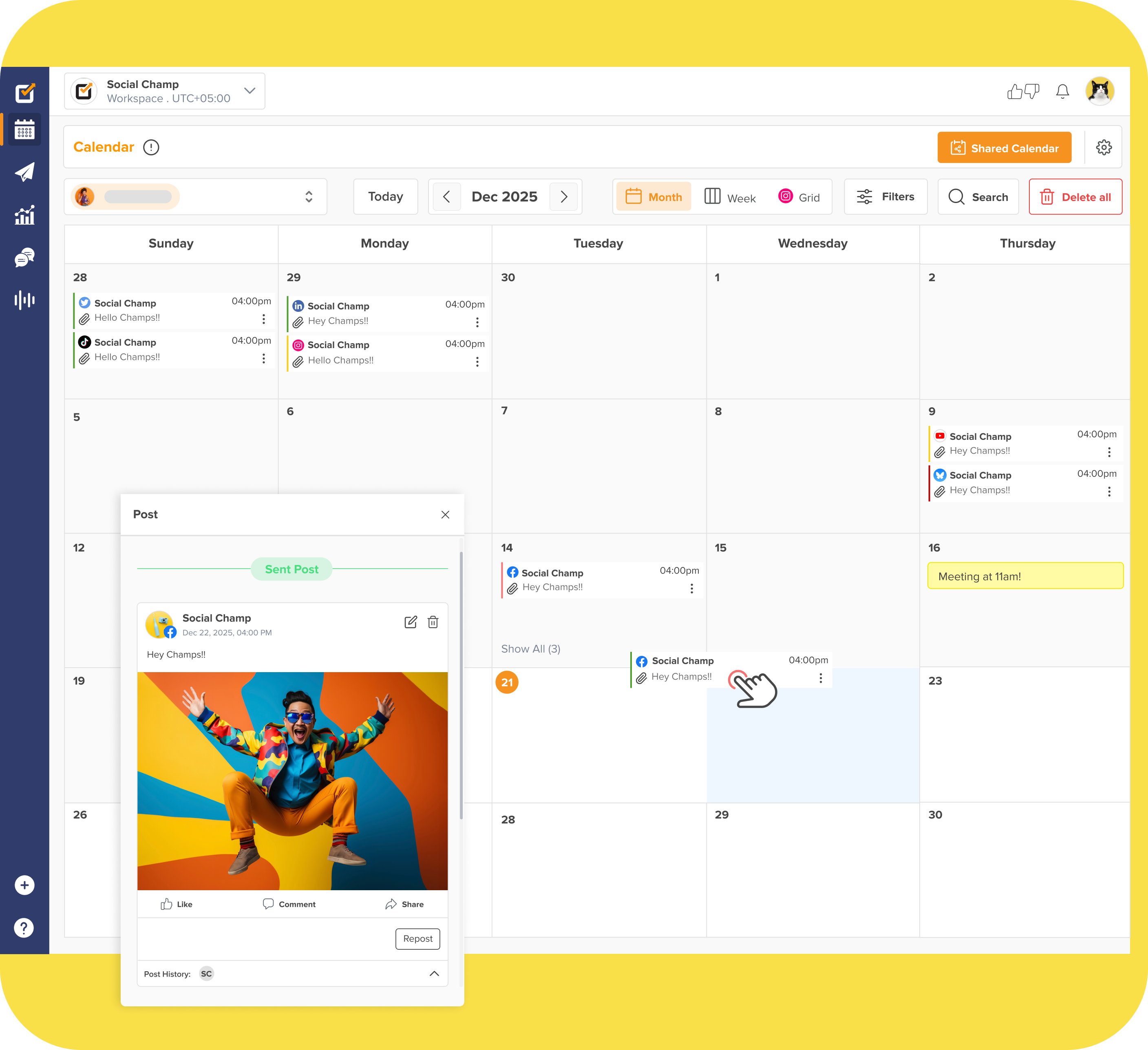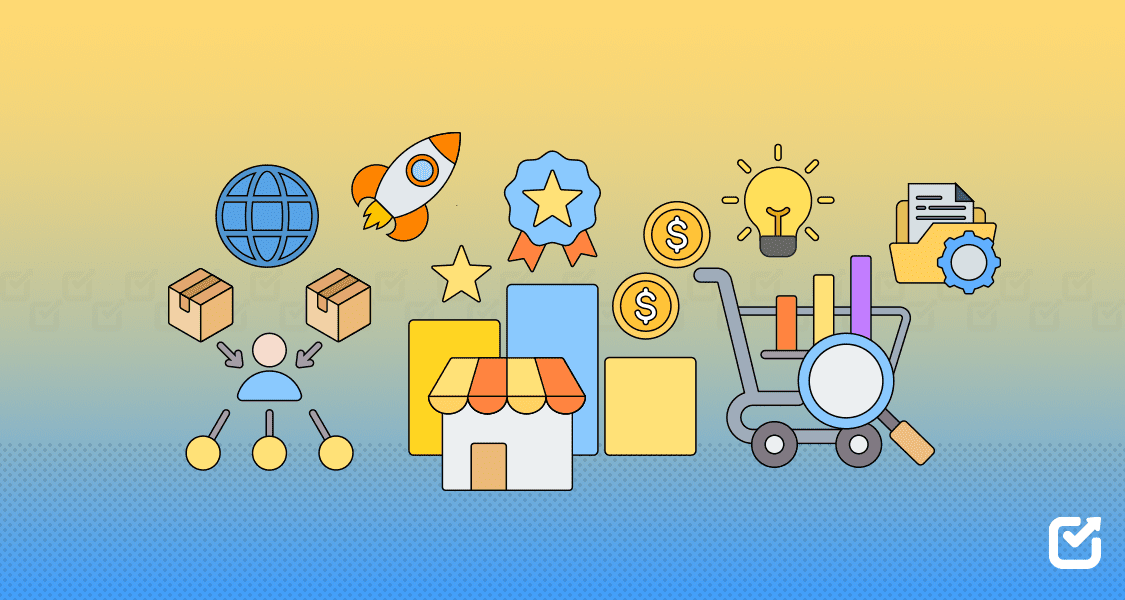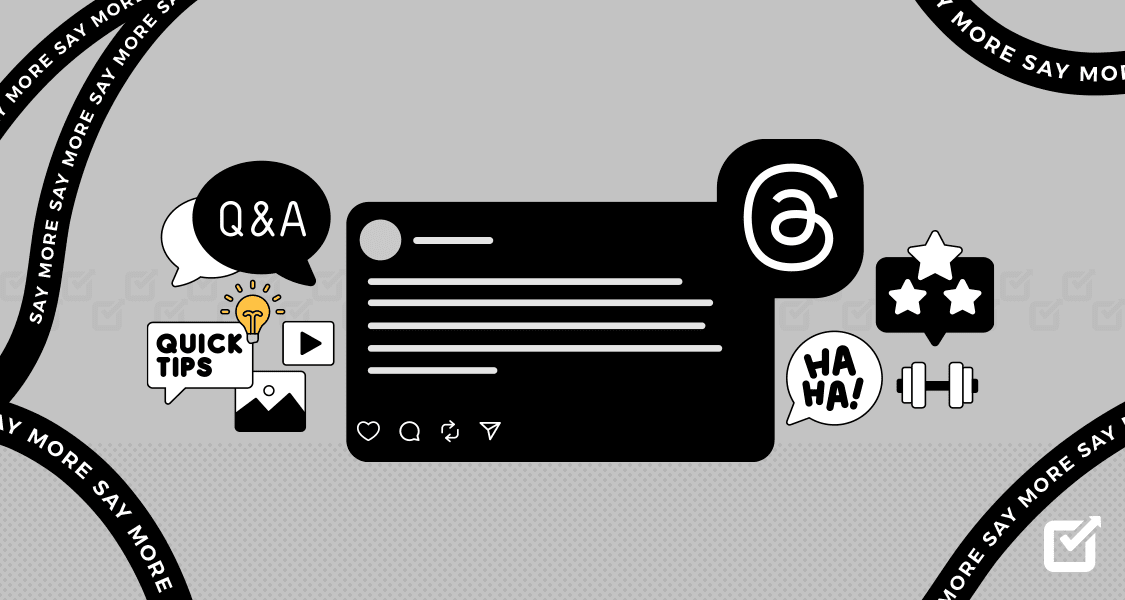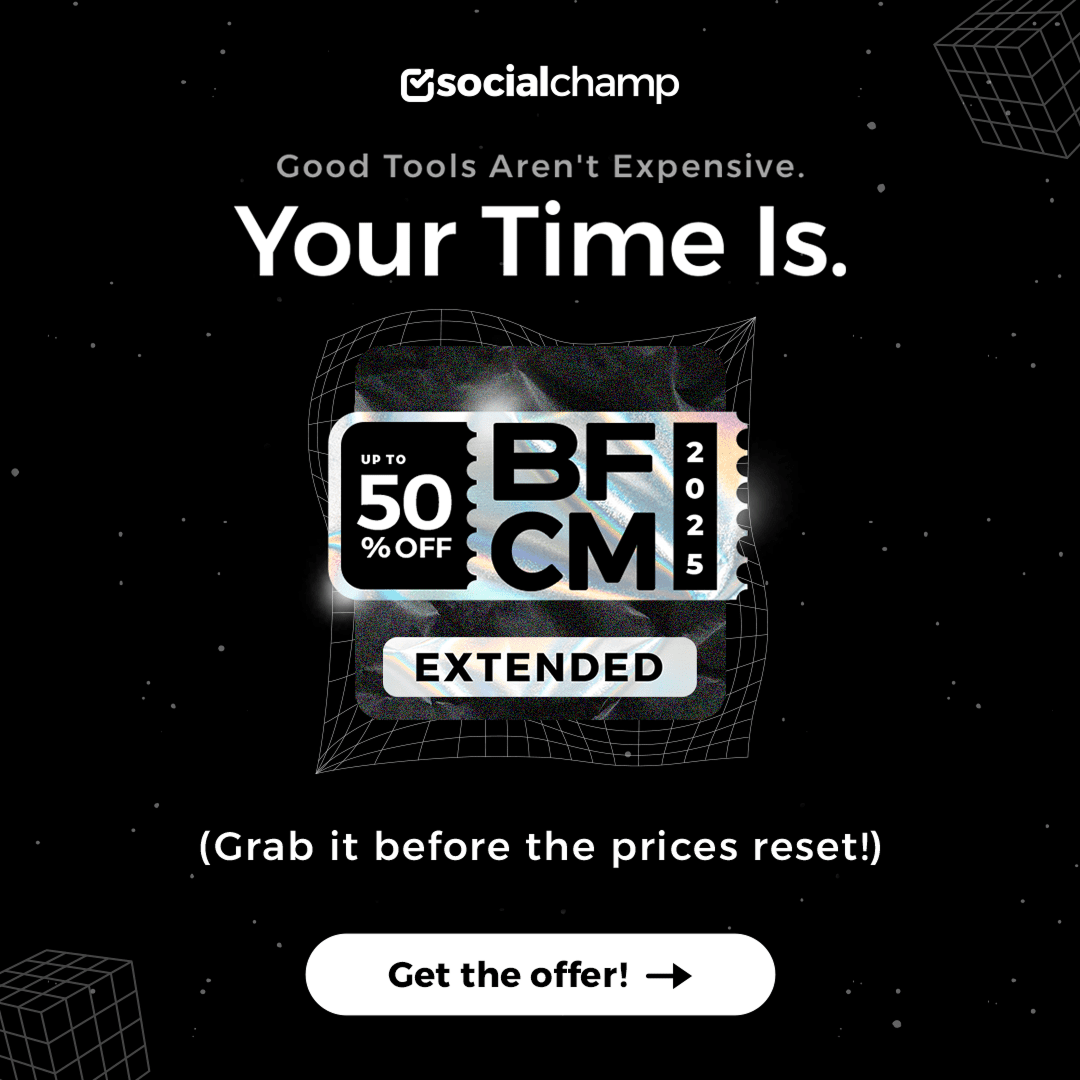You begin your business with big dreams.
Sitting in a small store (or behind a screen with a fresh website), you aim for customers flocking to your shop or owning a chain of retail stores after a few years.
Then you shake your head and think it is too far-fetched.
I’m here to tell you it’s not!
One of the many upsides of owning a business in 2025 is that you’re open to countless marketing channels and tried-and-tested strategies.
Today, I am going to tell you all about retail marketing. Whether you have an established retail store or an online startup, this blog has the perfect strategy for everyone.
You will learn what retail marketing is, its types, examples, top marketing strategies, and the best marketing tools you can use to streamline your process.

Consistency Drives Sales!
Automate your social media marketing with Social Champ and keep your customers engaged without the hassle.
Short Summary
- Retail marketing is essential for attracting customers, boosting sales, and staying competitive in both physical stores and online platforms.
- The 4Ps of retail marketing—Product, Price, Place, and Promotion—help shape effective retail marketing strategies.Types of retail marketing include in-store promotions, digital marketing, and omnichannel strategies.
- Key strategies for growth involve SEO, content marketing, paid advertising, influencer partnerships, referral programs, and pop-up store marketing.
- Retailers can improve customer engagement with loyalty programs, data-driven insights, and social media automation.
- Tracking key KPIs such as customer acquisition cost (CAC), conversion rates, and engagement metrics ensures continuous optimization and growth.
- Investing in automation tools like Social Champ simplifies social media management, improves consistency, and helps retailers scale effectively.
What Is Retail Marketing?
Retail marketing is how businesses attract customers, promote their products, and drive sales—whether through a physical store, an online shop, or both.
It’s more than just selling; it’s about creating an experience that makes people choose your brand over the competition.
In today’s fast-moving world, simply having a great product isn’t enough.
You need the right marketing approach to reach potential buyers, grab their attention, and keep them coming back.
Your retail marketing strategy can involve eye-catching in-store displays, social media promotions, influencer partnerships, or email campaigns.
The best hack is using a combination of these and many other strategies so you can increase brand visibility, improve brand positioning, outpace competitors, and all the while boost sales.
Featured Article: How to Get More Followers on TikTok in 2025: 30 Proven Strategies for Explosive Growth
The Importance of Retail Marketing in Today’s Competitive Landscape
In an era where consumers are bombarded with choices, strategic retail marketing enables your business to:
- Build Brand Awareness: Effective marketing ensures that potential customers recognize and remember your brand.
- Drive Customer Engagement: Engaging campaigns foster deeper connections with consumers, leading to increased loyalty.
- Enhance Customer Experience: Tailored marketing efforts can improve the overall shopping experience, encouraging repeat business.
- Boost Sales and Revenue: Targeted promotions and advertising can lead to higher conversion rates and sales.
The Digital Transformation of Retail Marketing
Retail marketing has evolved dramatically in recent years.
Traditional methods like newspaper ads and billboards have taken a backseat to retail digital marketing strategies that offer precise targeting and measurable results.
Online stores, social media advertising, AI-driven personalization, and omnichannel marketing have redefined how businesses connect with their audience.
For example, brands now use AI-powered recommendation engines to personalize shopping experiences.
At the same time, automation tools like Social Champ help businesses schedule content, manage multiple social media accounts, and track engagement—all from one dashboard.
Retailers who embrace these digital advancements can create seamless customer journeys that drive sales and build brand loyalty.

Simplify Your Retail Marketing Efforts With Social Champ
Schedule, automate, and analyze your social media campaigns effortlessly—start for free today!
Understanding the Retail Marketing Mix: The 4PS
Running a retail business in 2025 is more challenging than ever.
Customers have endless options, fierce competition, and a great product isn’t enough.
To attract customers, drive sales, and stay profitable, you need a solid retail marketing strategy—and that starts with mastering the 4Ps of retail marketing: Product, Price, Place, and Promotion.
If you’ve ever wondered why some retail businesses thrive while others struggle to get noticed, it all comes down to this marketing mix.
Determining what you want to sell, how much you want to sell it for, where you want to sell it, and how you want people to know about it makes up the core ingredients of your brand marketing recipe.
Get one wrong, and you most likely lose your ultimate business goal – making a profit.
Let’s break down each P and see how to apply it to your retail business.
-
Product – Selling the Right Items to the Right Audience
No matter what kind of retail business you run—a clothing boutique, a specialty food store, or an online electronics shop—your product selection is key.
Customers won’t buy just anything; they want relevant, high-quality, and value-delivering products.
How to Get It Right:
- Study customer demand: What are your bestsellers? What do customers ask for?
- Diversify wisely: Stock up on products that complement each other (e.g., a home decor store can add scented candles or artwork).
- Use data to adjust inventory: Don’t overstock slow-moving products. Use sales data to track trends.
Retailers who stay flexible with their product mix tend to attract repeat customers and increase sales.
-
Price – Setting Competitive & Profitable Pricing
Pricing is one of the trickiest parts of retail.
Set prices too high, and customers might go elsewhere.
Set them too low, and you might not cover costs.
The goal is to find the sweet spot where customers see value and you make a profit.
Effective Pricing Strategies:
- Cost-Plus Pricing: Add a fixed percentage to the product cost to ensure profitability. Commonly used in brick-and-mortar retail.
- Penetration Pricing: Set lower introductory prices to attract new customers and gain market share—perfect for launching new products.
- Competitive Pricing: Match or undercut competitor prices to stay relevant in a saturated market.
- Price Skimming: Start with high prices and gradually lower them—ideal for exclusive or seasonal products.
- Value-Based Pricing: Set prices based on the perceived value to customers rather than production costs. Works well for luxury or niche items.
- Bundle Pricing: Sell multiple products together at a discounted rate—like “Buy 2, Get 1 Free” promotions in apparel stores.
Retailers using data-driven pricing tools make better decisions and increase profitability without losing customers.
-
Place – Reaching Customers Where They Prefer to Shop
Your location—or how you “reach customers” — can make or break your business.
Physical stores need strong local visibility, while online retailers must focus on SEO, social media, and retail digital marketing.
Where Should You Sell?
- Brick-and-mortar stores: Use Google Business Profile to boost local visibility.
- E-commerce stores: Invest in a mobile-friendly website and fast checkout process.
- Social selling: Platforms like Facebook Marketplace and Instagram Shops let you sell directly.
Retailers who expand beyond one channel—combining in-store, online, and social selling—see higher customer engagement and more sales opportunities.
-
Promotion – Automate & Simplify Your Marketing
Marketing is what drives customers to your store or website, and this is where most businesses struggle.
Promotion isn’t just about running ads—it’s about creating the right message, at the right time, on the right platform.
The smartest retailers use marketing automation tools to stay consistent and visible.
How Social Champ Can Help:
Retailers don’t have time to manually post on every social platform. Social Champ lets you:
- Schedule weeks of social media posts in minutes.
- Auto-recycle your best-performing content.
- Track engagement and improve your strategy.
- Use AI-powered content suggestions to craft engaging posts
The retail businesses winning today, like Walmart or Costco, aren’t just selling good products—they’re using automation, smart pricing, multi-channel distribution, and strategic promotions to stand out, and so should you.

Want to Simplify Your Retail Marketing?
Try Social Champ to automate your social media promotions and free up time to focus on growing your business!
Types of Retail Marketing
Retail marketing has evolved far beyond traditional advertising.
With the rise of digital platforms and shifting consumer behaviors, retailers now have multiple ways to attract, engage, and retain customers.
Whether you own a local shop or an online store, understanding the right marketing approach can help you increase foot traffic, boost sales, and stay ahead of competitors.
Here are three essential types of retail marketing that every business should leverage.
-
In-Store Marketing
Capturing customer attention inside your store is just as important as attracting them in the first place.
Every element of your physical space—layout, signage, lighting, and even background music—affects the shopping experience.
Strategic product placement can increase impulse buys, while in-store promotions and loyalty programs encourage repeat visits.
For instance, placing high-demand or seasonal products near checkout counters can drive last-minute purchases.
Live product demonstrations and interactive displays also create engagement, making customers more likely to stay longer and buy more.
-
Digital and Social Media Marketing
Retailers no longer rely solely on foot traffic; digital channels offer limitless opportunities to engage customers.
Social media platforms like Instagram, Facebook, and TikTok provide a space to showcase products, interact with potential buyers, and run targeted ads.
A boutique clothing store, for example, can post daily outfit inspirations or behind-the-scenes content to build a loyal online community.
Email marketing is another powerful tool, allowing retailers to send personalized promotions, loyalty rewards, and reminders for abandoned carts—keeping their audience engaged beyond the store.
Keeping up with multiple social media platforms can be overwhelming, which is where Social Champ can help you out.
With automated post-scheduling and real-time analytics, businesses can stay consistent without spending hours manually posting.
Social Champ’s free plan ensures that even small retailers can maintain an active online presence without breaking the bank.
-
Omnichannel Strategies for Maximizing Reach
Customers today expect a seamless shopping experience across all channels—whether they’re visiting a store, browsing online, or engaging with a brand on social media.
Successful retailers integrate online and offline strategies to create a smooth buying journey.
Look at Sephora, for example; while it provides exceptional in-store experience, its online shopping service doesn’t fall short of it.
Moreover, it even provides a pick-up option.
If you hate browsing in stores while a salesperson follows you like a shadow but also despise waiting days for delivery, pick-up is the perfect solution.
Automation is another important aspect of modern omnichannel retailing.
AI-powered chatbots handle customer inquiries instantly, automated email sequences keep shoppers informed about their orders, and integrated POS systems ensure a consistent experience across all touchpoints.
Retailers who adopt this approach not only enhance customer satisfaction but also increase sales by catering to modern shopping habits.
Featured Article: How Do You Make Money on YouTube? A 2025 Guide to Success
Key Elements of a Winning Retail Marketing Strategy
A strong retail marketing strategy isn’t just about attracting customers—it’s about keeping them engaged, building loyalty, and maximizing your sales potential.
You need a structured approach that helps you understand your customers, make data-driven decisions, and streamline your efforts with the right tools.
Let’s break down the key elements that can take your retail business to the next level.
-
Customer Engagement & Loyalty Programs
Your customers have plenty of options, so why should they choose you every time?
The answer is customer loyalty.
Customer loyalty is the magic word that keeps people hooked to your brand.
They not only religiously follow your brand but also recommend it to others.
And the best part?
They scrunch their noses when your competitors are mentioned.
Ask an Apple user if you must.
Loyalty programs are the best way to keep your customers engaged with your brand.
It simply just gives them a reason to keep coming back.
Whether it’s exclusive discounts, personalized offers, or a points-based rewards system, these incentives strengthen customer relationships and boost repeat purchases.
Consider offering early access to sales, birthday discounts, or VIP perks to make shoppers feel valued.
When customers know they’re getting something extra, they’ll be more likely to stick with your brand.
-
Data-Driven Decision-Making With Analytics Tools
Making decisions based on guesswork can cost you sales.
Instead, use analytics tools to track your customers’ shopping habits, measure the performance of your marketing campaigns, and identify trends that can shape your strategy.
For example, if a product isn’t selling as expected, you can adjust pricing, tweak your promotions, or introduce bundle deals.
Tools like Google Analytics and Social Champ’s Analytics give you valuable insights to help you make smarter choices and increase profitability.
-
Streamlining Social Media Management With Social Champ
Social media is one of the most powerful marketing tools for retailers, but managing multiple platforms can eat up your time.
That’s where Social Champ comes in.
With automation features, you can schedule posts, track engagement, and analyze performance—all in one place.
From running Instagram promotions and Facebook campaigns to TikTok ads and LinkedIn posts, Social Champ helps you stay consistent and connected with your audience.

Retail Success Starts With Automation!
Use Social Champ to schedule posts, track performance, and keep your brand top of mind.
Proven Retail Marketing Strategies for Growth
Growing your retail business requires more than just good products—you need smart marketing strategies that attract new customers and keep them coming back.
Let’s explore the key retail marketing strategies that can fuel your business growth.
-
SEO & Content Marketing for Retail
Your customers are searching for products online—will they find you?
A strong SEO and content marketing strategy helps your retail business appear in search results when potential buyers are looking for what you offer.
Start by optimizing your website with relevant keywords, product descriptions, and blog content that educates and engages your audience.
For example, if you run a fashion boutique, publishing style guides or trend reports can drive organic traffic to your site.
Platforms like Yoast SEO can help improve your search rankings, making it easier for customers to discover your store.

Example of Google Search Results -
Paid Advertising & Influencer Partnerships
Sometimes, organic growth isn’t enough.
Paid advertising allows you to target the right audience and drive quick results.
Running Google Ads, Facebook campaigns, or Instagram promotions can help you reach potential customers based on their interests and shopping behavior.
Additionally, influencer partnerships can give your brand a credibility boost.
Collaborating with influencers in your niche—whether it’s beauty, fashion, or home decor—helps you tap into their loyal audience.
Even micro-influencers with a few thousand engaged followers can drive significant sales.

Walmart’s Post Example on Instagram. -
Automating Social Media Posting With Social Champ to Maintain Consistency
Managing social media for your retail business can feel overwhelming, especially when you need to stay active on multiple platforms.
Automating your posts ensures that your content reaches customers at the right time without requiring daily effort.
Social Champ allows you to schedule posts across different channels, engage with your audience, and track performance—all from one dashboard.
With features like bulk scheduling and analytics, you can optimize your content strategy while saving time.

Social Champ’s Dashboard -
Referral Programs: Turning Customers Into Brand Advocates
Word-of-mouth marketing is one of the most powerful ways to grow your business.
A referral program incentivizes happy customers to spread the word about your brand.
Offering discounts, exclusive perks, or store credit in exchange for referrals encourages shoppers to bring in new customers.
Retail Brands like Costco have successfully used referral programs to skyrocket their growth.
You don’t need a massive budget—just a simple system that rewards customers for sharing their positive experiences.

Costco’s Referral Bonus Program -
Pop-up Stores: Creating Excitement & Boosting Sales
Pop-up stores are a fantastic way to generate buzz, test new markets, and create an immersive shopping experience.
These temporary retail spaces allow you to engage customers uniquely, whether through exclusive product launches, seasonal collections, or interactive brand experiences.
If you’re an online retailer, opening a short-term store in a high-traffic area can help increase visibility and attract new customers.
An excellent example is Shein opening up various pop-up stores across different countries.

Shein’s Pop-up Store
Measuring Retail Marketing Success: Key KPIs
A well-executed retail marketing strategy means nothing without proper measurement.
Tracking key performance indicators (KPIs) helps you assess the effectiveness of your campaigns, optimize spending, and refine future strategies.
Here are some crucial metrics every retailer should monitor:
-
Customer Acquisition Cost (CAC)
CAC measures how much you spend to acquire a new customer.
It includes marketing expenses like ads, promotions, and content creation, divided by the number of new customers gained.
-
Conversion Rate
Your conversion rate reflects the percentage of visitors who complete a desired action, such as making a purchase, signing up for a newsletter, or adding items to their cart.
-
Customer Lifetime Value (CLV)
CLV measures the total revenue a customer generates over their relationship with your business.
-
Average Order Value (AOV)
AOV tracks the average amount spent each time a customer places an order.
-
Return on Ad Spend (ROAS)
ROAS calculates how much revenue you generate for every dollar spent on advertising.
-
Engagement Metrics (Likes, Shares, Comments, Clicks)
Engagement metrics include likes, comments, shares, and click-through rates (CTR), etc to measure your SM marketing performance.
-
Customer Retention Rate
High retention rates indicate strong brand loyalty, while a low rate suggests issues with customer satisfaction or product quality.
How Social Champ’s Analytics Can Help
Tracking social media performance is vital for understanding how your content influences customer behavior.
Social Champ’s analytics provide in-depth insights into engagement trends, audience growth, and post performance.
You can monitor key social metrics, measure campaign effectiveness, and adjust strategies in real time to maximize ROI.
Conclusion
Retail marketing is constantly evolving, and staying ahead requires a strategic approach.
From optimizing pricing and promotions to leveraging digital and in-store marketing, every element plays a role in driving sales and customer loyalty.
The key is to stay data-driven, test new strategies, and refine your efforts based on performance insights.
Investing in automation tools like Social Champ can make a significant difference by streamlining social media management, maintaining consistency, and tracking engagement.
The right tools help you save time, enhance efficiency, and focus on growing your business.

Is Your Retail Marketing Reaching the Right Audience?
Use Social Champ to automate campaigns, engage customers, and drive more foot traffic and sales.









